Tiger botia - Syncrossus berdmorei
Scientific name: Syncrossus berdmorei
Common name: Tiger botia
Family: Cobitidae
Usual size in fish tanks: 22 - 25 cm (8.66 - 9.84 inch)
014
Recommended pH range: 6.5 - 7.5
Recommended water hardness: 2 - 12°N (35.71 - 214.29ppm)
0°C 32°F30°C 86°F
Recommended temperature range: 22 - 27 °C (71.6 - 80.6°F)
The way how these fish reproduce: Spawning
Where the species comes from: Southeast Asia
Temperament to its own species: peaceful
Temperament toward other fish species: aggressive to smaller
Usual place in the tank: Bottom levels
General Information
Tiger botia (Syncrossus berdmorei), often sold as the Redfin Tiger Loach, is a robust river loach native to Southeast Asia—primarily the Irrawaddy, Sittaung and Salween systems (Myanmar) with records from Thailand and adjacent NE India. Adults routinely reach 22–25 cm (8.5–10″), making this a large, high-energy loach unsuited to small aquaria. It retains striking red/orange fins into adulthood and shows strong social hierarchies.
Food & Feeding
Omnivorous with a carnivorous bias. Provide a staple of quality sinking pellets and rotate meaty items: frozen/live bloodworms, brine shrimp, chopped prawn, mysis; plus occasional vegetable matter (blanched spinach/peas, spirulina wafers). They readily predate snails. Feed modest portions 1–2× daily; overfeeding quickly degrades water in high-protein diets.
Sexing
No reliable juvenile differences. Mature females tend to be deeper-bodied/plumper; males remain slightly slimmer. Sexing is best via comparison within a group.
Breeding
S. berdmorei is a seasonal egg-scatterer in nature. There are no verified, routine aquarium spawnings; farm production (if any) is typically via hormonal induction. Expect to keep this species for display rather than home breeding.
Lifespan
Commonly 10 years with space, current and clean water; reports vary higher under ideal care.
Tank Requirements & Water Parameters
- Minimum tank: start at 120 cm / 4 ft length for juveniles; 150–180 cm (5–6 ft) is far better for adults or groups.
- Substrate: fine sand (essential) to protect barbels; add rounded stones/wood for lanes and cover.
- Flow & oxygen: moderate–strong current, high O2, impeccable filtration; they hail from clear, running rivers.
- Water: pH ~6.5–7.5; hardness ~2–12 °dH; temperature 22–27 °C (71.6–80.6 °F). Stability and low nitrate are key.
- Maintenance: large, regular water changes; tight-fitting lid (excellent jumpers).
Compatibility & Social Behavior
Not peaceful. This is an assertive, territorial loach with a strict pecking order. Best kept either as a single specimen or in a group of 5 individuals to spread aggression. Provide abundant hides and broken sight-lines. Choose robust, fast tank mates (larger barbs, tough rainbows, similar loaches); avoid small, slow or long-finned fish that will be harassed.
Behaviour & Usual Place in the Tank
Primarily a bottom-dweller that forages and digs; crepuscular but active by day in secure setups. Expect audible “clicking” during interactions and feeding.
Care Notes
- Introduce only to mature, clean systems; they are intolerant of high organics.
- Provide multiple caves/tubes and wood piles to reduce line-of-sight and aggression.
- Quarantine new arrivals; wild fish often carry parasites and need time to recover condition.
Short Description
Tiger botia (Syncrossus berdmorei) is a big, striking river loach from Myanmar/Thailand drainages. Keep on sand with current, high oxygen and many hides. House singly or in a proper group of 5 with equally robust tank mates; feed varied sinking foods and expect a long-lived, charismatic but feisty fish.
Q&A
- How large do they get? Commonly 22–25 cm (8.5–10″) in aquaria.
- Are they community-safe? With large, fast, assertive species, yes. They bully small/slow fish.
- Can they live on gravel? Use sand only; gravel damages barbels and invites infection.
- Group or single? Either one or a group of 5 ; never pairs/trios (concentrates aggression).
Pictures
Bought by aqua-fish.net from jjphoto.dk.
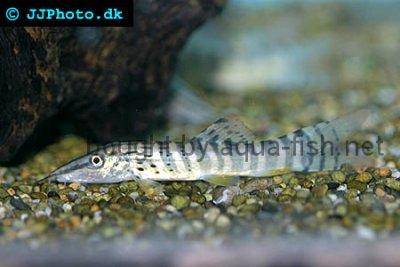





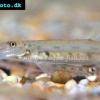 Horseface
Horseface 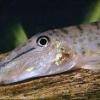 Horseface
Horseface 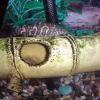 YoYo
YoYo 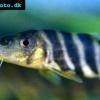 Bengal
Bengal 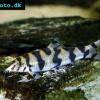 Burmese
Burmese  Myanmar
Myanmar 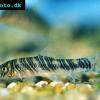 Zebra
Zebra 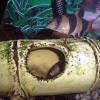 Clown
Clown  Dojo
Dojo 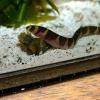 Kuhli
Kuhli  Loach
Loach 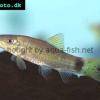 Tailspot
Tailspot 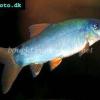 Blue
Blue